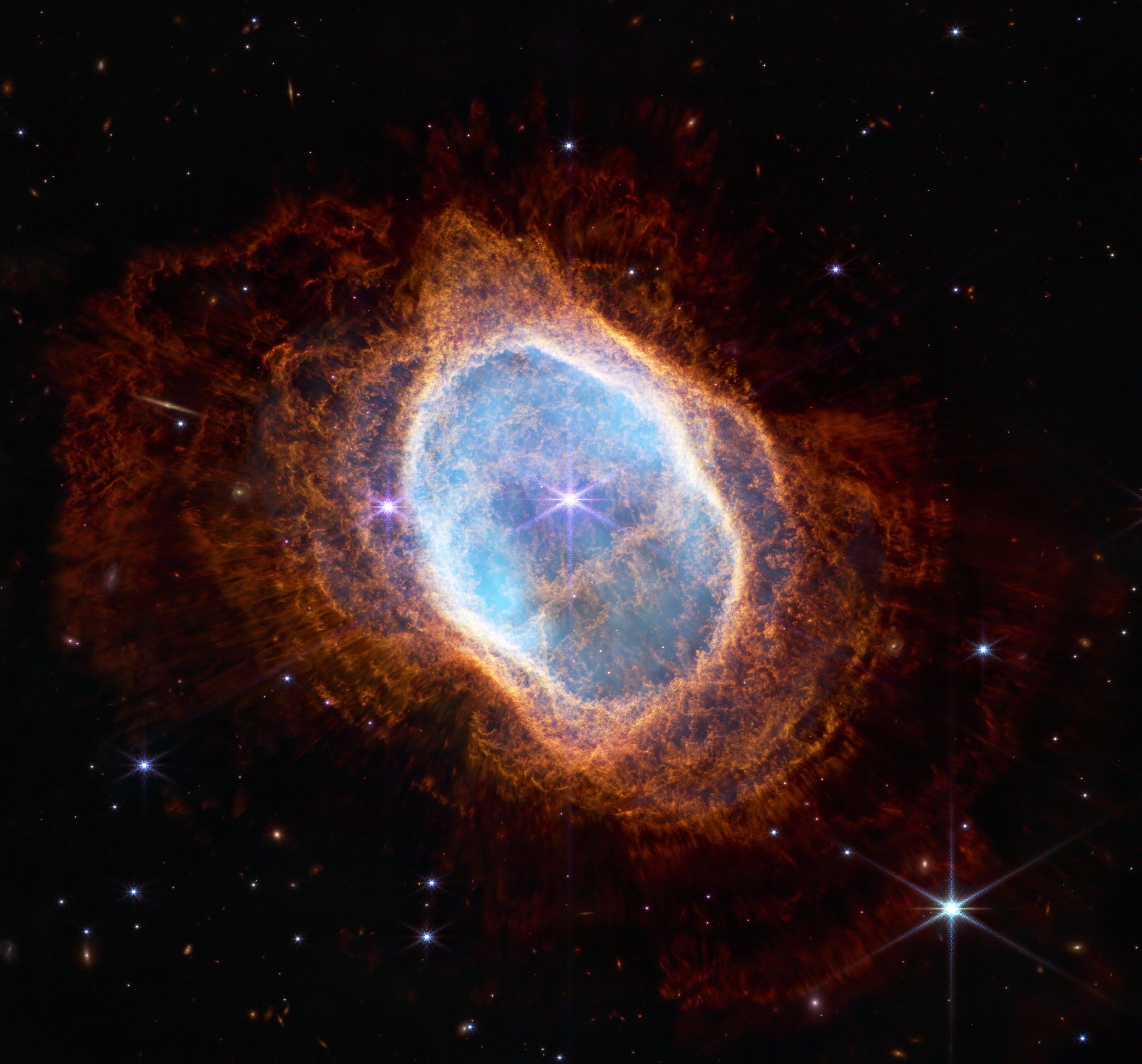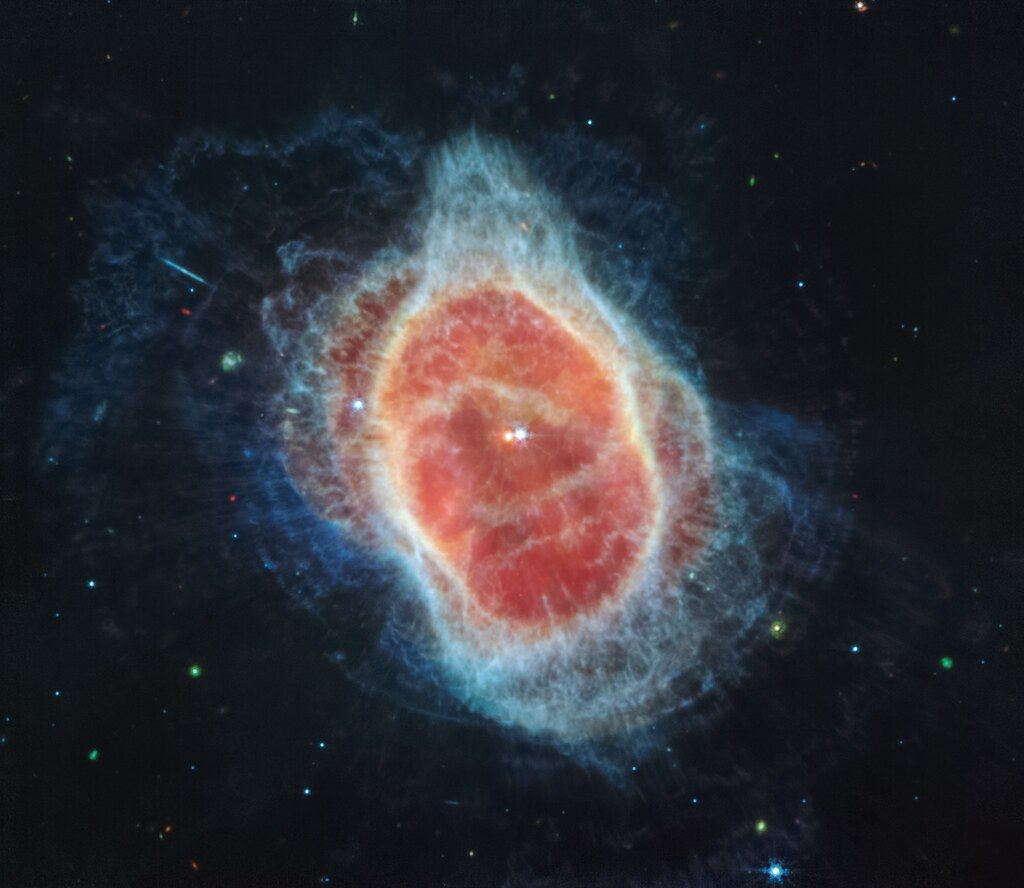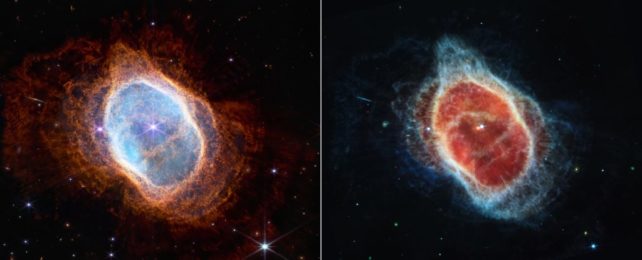The intricate whorls and curlicues of the Southern Ring Nebula – recently made famous for its place as one of the first objects imaged by JWST – are the product of at least four stars, new research has revealed.
Studying images from the new space telescope, an international team of astronomers has found previously unknown stars in the cloud of glowing gas and plasma.
The presence of these stars explains the structures still being carved out as the nebula expands, the product of the violent death of the single star at the nebula's center.
"We were surprised to find evidence of two or three companion stars that probably hastened its death as well as one more 'innocent bystander' star that got caught up in the interaction," explains astrophysicist Orsola De Marco of Macquarie University in Australia, who led the research.
Planetary nebulae like the Southern Ring Nebula form from the death of a star like the Sun. When the star starts to run out of the fuel needed for nuclear fusion in its core, it puffs up to hundreds of times bigger, expanding outwards into a red giant.
Eventually, the fuel is exhausted, and the star's outer material is ejected into space while the core collapses into a white dwarf. The ejected material continues to expand outwards and, ionized by the radiation from the white dwarf (which will continue to shine with residual heat for potentially trillions of years), shines with fluorescence.
This is the planetary nebula, so-named because, without interference by other objects, they tend to be quite spherical, resembling a planet.

But if there's something else near the star – and there often is, since many stars are in multiple-star systems gravitationally bound together – magnificent structures can form in the nebula as it travels through space.
The Southern Ring Nebula, officially named NGC 3132 and located some 2,460 light-years away, is the death shroud of a star that was an estimated three times the mass of the Sun in life. Now, that star is a small, dense white dwarf, around half the mass of the Sun, packed into a sphere around the size of Earth.
It's also surrounded by a cloud of cool dust that makes it difficult to see. The JWST image released in July marked the clearest view of it ever obtained – the infrared and near-infrared wavelengths of light in which JWST views the Universe can penetrate dust more effectively than other wavelengths.
But there was a lot more to be found in the image.
"When we first saw the images, we knew we had to do something, we must investigate!" De Marco says. "The community came together, and from this one image of a randomly chosen nebula, we were able to discern much more precise structures than ever before."
There's a second star close to the center of the nebula. It, too, was already known, a binary companion to the white dwarf. This star is at an earlier stage of its life and is still on the main sequence, yet to commence the series of transformations that mark the end of its days.
Spiral structures creating arches around the center of the nebula are the product of the orbital dance of these two stars – the dead white dwarf and its living companion. But when the researchers conducted a three-dimensional reconstruction of the nebula, they found pairs of structures that form when objects such as stars and black holes spew jets of plasma from their poles.

This suggested that more stars are present in a convoluted stellar waltz.
"We first inferred the presence of a close companion because of the dusty disk around the central star, the further partner that created the arches, and the super far companion that you can see in the image," De Marco explains.
"Once we saw the jets, we knew there had to be another star or even two involved at the center, so we believe there are one or two very close companions, an additional one at middle distance and one very far away. If this is the case, there are four or even five objects involved in this messy death."
The new images also allowed the researchers to perform a new calculation of the white dwarf's temperature. It's burning at around 110,000 Kelvin (about 109,700 degrees Celsius, or 197,540 degrees Fahrenheit).
Planetary nebulae are relatively short-lived phenomena, only fluorescing for about 10,000 years before dissipating into interstellar space. So in one sense, we are very lucky to have caught this stage in the life cycle of the Southern Ring Nebula. The team's results are also important for studying this period in the life of a white dwarf and the interactions that can occur.
And interestingly, the discovery of several new stars gravitationally bound together has implications for gravitational wave astronomy. White dwarfs are on a continuum of dense objects; they have the lowest mass and the lowest density, followed by neutron stars and black holes.
It's possible that "messy" systems like the Southern Ring Nebula could, in the future, result in multiple successive collisions between dead stars, resulting in objects with masses that are impossible to form from a single star.
The researchers said that studying more such objects with JWST could help us better understand how they form and inform future observations.
The research has been published in Nature Astronomy.
